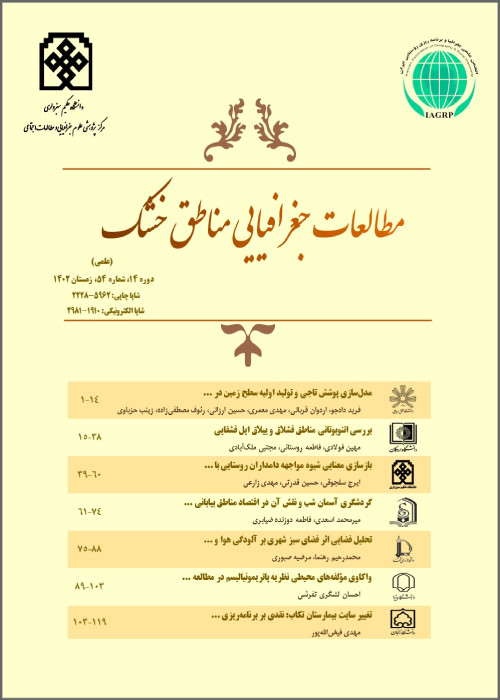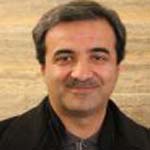Analysis and Evaluation of Sediment Estimated of Miyaneh Shaharchay Basin Using EPM and Fournier Models In GIS Environment
Author(s):
Abstract:
Introduction
Erosion, especially soil erosion is a serious threat to soil and water resources, because the soil consists of a combination of small-scale materials, non-organic and organic materials, also is a natural, dynamic environment that the growth of plants depends on it. Nowadays, soil erosion is one of the issues and problems that causes serious damages in Iran. Every year, nearly 75 billion tons of fertile soil and billions of tons of other agricultural land soil erode. The present research aims at investigating the EPM and Fournier models, validating the aforementioned models with the observed data of hydrometric station of Kouhsalar located at Mianeh, and introducing Fournier model instead of the costly and time-consuming models to estimate the sediment in case of its being valid in the area under study.Materials and
Methodology
Shaharchai basin with an approximate area of 1510 square kilometers is located in the Eastern Azarbaijan Province and in the northwest part of the city of Mianeh and is one of the branches of the Gezel Uzan river.In the present research to achieve the desired goal, the following materials were used including: topographic map, geological map of the region, satellite images of Landsat 8 in 2014, and 1:20,000 aerial photos, for the preparation of the current state of the erosion and land cover, as well as the use of soil science studies of identification-justification stage report of hydrometric areas of Shaharchai basin in 2007, the data of precipitation and evaporation Survey stations on a monthly basis for use in the models and data of Kouhsalar hydrometric station in order to estimate sediment of the basin.
The software Arc GIS was used for preparing thematic maps, including maps of isotemperature and isoprecipitation lines, maps of land use - land cover and the formation of the database, the software ENVI5 was used for extracting data related to the land use - land cover in the area.
The models used in this research are EPM and Fournier by using GIS to estimate the sediment.
In the present investigation after obtaining the amount of sediment estimates for each of the sub-basins, the data of 40 years (1973-2013) of hydrometric station of Kouhsalar were used for validation of the results of the models. One of the common methods for calculating the production of suspended sediment is to use the method of sediment rating curve-daily stream discharge. The required data for drawing the sediment rating curve and calculating the respect of current are discharge estimates and corresponding sediment discharge. Then, to compare the results of observation, percentage of relative error (RE) was used.
Results And Discussion
The necessary data for the estimation of erosion and sedimentation of the region after the weighting and calculating was obtained for each of the sub-basins. The intensity and the percentage of erosion area of the basin is shown in a table. Map of the intensity of erosion reflects the severity of the erosion of the area under study in three classes of Very Low, Low, and Medium. Although the severity of the erosion of the Medium class has a dramatically considerable percentage of the area, the highest percentage is related to the intensity of the Low class of erosion.The Medium class of erosion is about 26%. In this class of the erosion, separation and movement of soil particles is to the extent that the implementation of soil and water conservation programs is required. Most of these areas are located on rangelands, and effective factors in these areas include high slope, poor coverage, and structures sensitive to erosion. In these areas, mechanical operations should be carried out more carefully and with caution. Preservation of pasture plants, biological operations, and preventing animals grazing are strictly recommended.
Conclusion
In the present research, the models of erosion with the aim of determining the best model for the estimation of the sedimentation of the catchment area of Shaharchai Mianeh basin were applied. Because of the simplicity and low cost of Fournier model, it was investigated. But because of its being too simple and not taking into account the parameters influencing the erosion, the Fournier model cannot be a good alternative to costly and time-consuming models such as EMPSIAC or EPM. In the validation of EPM model, using the observed data, relative coincidence with 9.9% difference fits fairly well. Considering the absolute value of the difference in EPM with the observed data, the amount of sediment reached 200,454 tons per year. This amount of sediment is due to the large area of Medium class of erosion. In this class, erosion, separation, and movement of soil particles is to the extent that soil and water conservation programs are necessary. Keywords:
Language:
Persian
Published:
Arid regions Geographic Studies, Volume:6 Issue: 23, 2016
Pages:
82 to 95
magiran.com/p1605468
دانلود و مطالعه متن این مقاله با یکی از روشهای زیر امکان پذیر است:
اشتراک شخصی
با عضویت و پرداخت آنلاین حق اشتراک یکساله به مبلغ 1,390,000ريال میتوانید 70 عنوان مطلب دانلود کنید!
اشتراک سازمانی
به کتابخانه دانشگاه یا محل کار خود پیشنهاد کنید تا اشتراک سازمانی این پایگاه را برای دسترسی نامحدود همه کاربران به متن مطالب تهیه نمایند!
توجه!
- حق عضویت دریافتی صرف حمایت از نشریات عضو و نگهداری، تکمیل و توسعه مگیران میشود.
- پرداخت حق اشتراک و دانلود مقالات اجازه بازنشر آن در سایر رسانههای چاپی و دیجیتال را به کاربر نمیدهد.
دسترسی سراسری کاربران دانشگاه پیام نور!
اعضای هیئت علمی و دانشجویان دانشگاه پیام نور در سراسر کشور، در صورت ثبت نام با ایمیل دانشگاهی، تا پایان فروردین ماه 1403 به مقالات سایت دسترسی خواهند داشت!
In order to view content subscription is required
Personal subscription
Subscribe magiran.com for 70 € euros via PayPal and download 70 articles during a year.
Organization subscription
Please contact us to subscribe your university or library for unlimited access!



